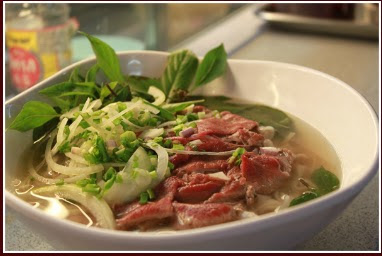Vietnamese meals are a treasure trove of color, texture and perfectly balanced tastes
Both cooking and eating are very important parts of
Vietnam’s culture. Like most things in
their culture, the principle of yin-yang exerts a significant influence in
Vietnamese life and food is no exception. Harmony is key, so it’s no wonder that Vietnamese
cooking respects the rules of balance. The
five senses (sight, smell, hearing, taste and touch) play a major role in
creating harmony.
Home cooks can be very clever in creating something from nothing
An important part of Vietnam’s cuisine is first “eating with
your eyes.” Dishes are very colorful,
and often have decorative elements.
Fruit and vegetable carving is an art-form in Vietnam and markets are
full of a variety of clever utensils that can quickly turn a carrot or radish
into a swan or a flower. Even in family homes the most
simple of dishes are adorned with decorations.
In sophisticated restaurants, chefs create masterpieces carved from the
country’s rainbow of tropical fruits or vegetables.
The sense of smell is very important in Vietnamese
cooking. A variety of pungent aromatic
herbs and spices are used to enhance smell.
Vietnam’s famous Pho soup broth is layered in its many hours of cooking
with a variety of herbs and spices such as lemongrass, star anise,
peppercorns, and ginger. But the complex
nose of the broth is just one of the smells.
Pho is always served with a side plate of garnishes including pungent purple basil, aromatic cilantro, fragrant mint, and a spicy-smelling chili. All of these individual notes come together in tiny amounts to complete the balance.
The complex broth of aromatic Pho is mixed with a melange of equally perfumed fresh herbs
The sense of sound can play into the enjoyment of a
meal in Vietnam. Crunchy sounds are an
important part of Vietnamese dining.
Soft foods (e.g. noodles) frequently have something crispy for
balance (such as peanuts). Crispy fried
shallots are sold in every store.
Another crunch element, these shallots often are used to top a soft rice
dish, completing the perfect sound and harmonious textural bite.
Touch is also an important sense in Vietnam’s cuisine. Egg rolls and spring rolls are both examples of hands actually touching the food. Often served as appetizers to awaken the appetite, the sense of direct contact with the food is an important opening to the remainder of the meal.
Vietnam's classical dipping sauce provides sweet, sour, salty, & spicy in each bite
Last, but not least is the sense of taste. There are five elements that must be present
for there to be harmony in the taste:
spicy, sour, bitter, salty and sweet.
Vietnam’s famous dipping sauce (nuoc
cham) includes four of the five (bitter is missing), so this condiment always accompanies bitter stir-fried greens. Everything on the plate is meant to be eaten in concert, creating the perfect balance in each bite.
Duck ("cool") is often served with ginger ("hot")
While ensuring that all of the senses are awakened is
vital in Vietnam’s cuisine, there’s also another critical tenet to the yin-yang
balance---that of the heating and cooling properties of foods. Spicy foods (such as ginger) are thought to provide
“heat.” These foods are always paired
with other foods (or side dishes) that are considered to be “cool.” Pickled vegetables, for example, are quite popular
in Vietnamese dining as they are considered to be a cooling element. Similarly, Vietnam’s ubiquitous fish sauce is
considered warm, and it is always balanced by something cool. The classical Vietnamese dipping sauce is a
popular concoction that combines fish sauce with sugar and vinegar---both the
latter ingredients are considered cool, thus they create the perfect balance.
Come and experience this culinary harmony with Wine-Knows
on their food tour of Vietnam. This trip
will begin immediately following the celebration of the Asian New Year in
February 2020---a very special time of year.








No comments:
Post a Comment